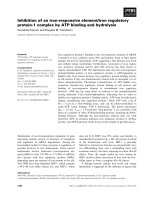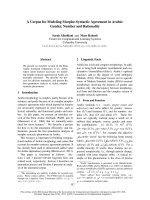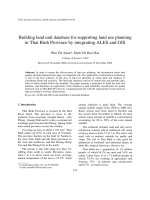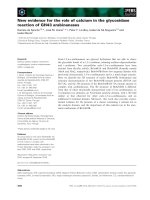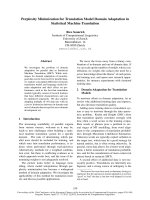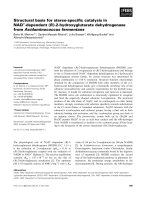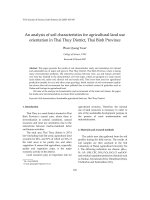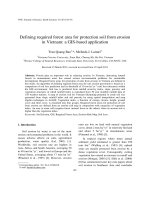Báo cáo " Building land unit database for supporting land use planning in Thai Binh Province by integrating ALES and GIS " doc
Bạn đang xem bản rút gọn của tài liệu. Xem và tải ngay bản đầy đủ của tài liệu tại đây (121.61 KB, 7 trang )
VNUJournalofScience,EarthSciences24(2008)153‐159
153
Building land unit database for supporting land use planning
in Thai Binh Province by integrating ALES and GIS
Nhu Thi Xuan*, Dinh Thi Bao Hoa
College of Science, VNU
Received 5 November 2008; received in revised form 25 November 2008
Abstract. In order to ensure the effectiveness of land use planning, the information about land
quality and land characteristics plays an important role. The application of information technology
is one of the best solutions in the area of land use planning in which land unit database is
considered firstly and seriously. The land unit database consists of spatial data and attribute data,
both of which should follow the standard. The paper presents a procedure to build the land unit
database, and illustrates an application of the database to land suitability classification for paddy
field and crop in Thai Binh Province by comparing land unit with the requirement of each land use
type according to ecology characteristic.
Keywords: ALES and GIS; Land suitability; Land unit database.
1. Introduction
*
Thai Binh Province is located in the Red
River Delta. The province is close to the
northern focus economic triangle Hanoi - Hai
Phong - Quang Ninh and it is also a commercial
exchange gate between Hai Phong, Quang Ninh
and coastal provinces across the country.
Covering an area of about 1,535 km
2
, Thai
Binh makes up 0.5% of total area of Vietnam.
The province borders on the Gulf of Tonkin in
the east, Nam Dinh and Ha Nam provinces in
the west and southwest, and Hai Duong, Hung
Yen and Hai Phong City in the north.
The terrain is flat with slope less than 1%
stiffing from north to south. Elevation varies
from 1 to 2 m above mean sea level. Average
annual temperature of the area is 23.3
0
C. Total
_______
*
Corresponding author. Tel.: 84-913083269.
E-mail:
annual radiation is quite high. The average
annual rainfall ranges from 1600 to 2000 mm.
Rainy season lasts from April to October and
dry season from November to March. In rainy
season, large amount of rainfall is concentrated,
accounting for 80 to 90% of the total annual
rainfall.
The sediment includes mud and clay and is
red-brown colored. pH of stabilized soil, loam
or heavy loam is from 7.2 to 7.6. The soil is soft
mud, rich in nutrient suitable for paddy and
crops. The soil in Thai Binh is also good for
plantation of foodstuff and industrial plants of
short life, tropical fruit trees, flowers, etc.
Thai Binh has a population of 1.8 million
people, of which 94.2% are rural and 5.8% are
urban. Labor force is of 1.73 million people in
which 74.3% are working in agriculture and
forestry; 17% - in industry and construction;
and 8.7% - in trade service.
N.T.Xuan,D.T.B.Hoa/VNUJournalofScience,EarthSciences24(2008)153‐159
154
Total natural land area across the province
is 153,596 ha, of which 94,187 ha is under
cultivation. Thai Binh possesses fertile land and
large labor force working in agriculture having
experiences in cultivating 3-4 crops annually in
one year. The convenient irrigational system
has partly helped build up paddy fields yielding
up to 14-15 tons/ha.
The purpose of this research is to build the
database for land suitability classification by
using integration ALES and GIS.
2. Materials and methods
The FAO method is based on matching land
quality (supply side, the land) versus land use
requirements (demand side, product). The key
of this method is to divide the landscape of the
studied area into specific types of land units
called land systems. The land system concept,
as explained by most scholars, is based on
ecological principles and presumes closely
interdependent links between parameters such
as agro climate regime, rock types, landforms,
soils, hydrological conditions and living
organisms etc.
The first FAO publication setting out the
principles of land evaluation as well as the
broad methodological approach for identifying
a range of relevant agricultural land-use options
for a given area appeared in 1976, "A
framework for land evaluation" (referred to
hereafter as the '1976 Framework') (FAO,
1976). Subsequent FAO guidelines on land
evaluation concerned detailed application of the
1976 Framework to several specific major land
uses, namely, rain-fed agriculture, irrigated
agriculture, livestock and forestry production
(FAO, 1983; 1984; 1985; 1991 respectively).
An example of the application at the national
scale of automated approaches to land
evaluation that are based on the original 1976
Framework principles was published in 1993
(FAO/UNEP, 1993) [1, 3].
More recently, the dynamic process of land
use planning, the high demand for information
on the suitability of land for various uses, and
the advances in IT opened the possibilities for
more automated systems where data storage,
processing (rule-based), retrieval and iteration
are facilitated. This is when software packages
such as ALES (Automated Land Evaluation
System) and some the others were introduced.
The ALES (the Automated Land Evaluation
System) is developed at Cornell University
follows the principles of FAO’s 1976 Framework.
In ALES, expert users can describe proposed
land uses, as well as the geographical areas to
be evaluated, using their own set of criteria based
on their local knowledge, and subsequently
allow the program to automatically do the
matching [5].
Regarding the land evaluation
methodology, each observation was singularly
evaluated and attributed to one of the four
suitability classes (0: not suitable, S1: very
suitable, S2: moderately suitable, S3:
marginally suitable).
3. Database building
The land units of the Thai Binh Province
were digitized using ArcGIS software and
presented with the attribute data as index map
codification system. The database will be later
built at scale of 1:50.000 based on the chosen
parameters and characteristics of land units.
After finishing, the existing land unit database
contains only spatial data which is based on the
georeference of topographic map. The thematic
attribute data which describe the properties of
land unit system, were not yet stored in digital
format. Therefore, land unit database were not
ready to be integrated with other thematic data.
The further step is to organize the land unit
database so that the spatial data are
appropriately described by the attribute data for
spatial land use planning [4, 5].
N.T.Xuan,D.T.B.Hoa/VNUJournalofScience,EarthSciences24(2008)153‐159
155
3.1. Spatial data georeferencing
The current trend of GIS users in applying
integrated data for various purposes is to
develop spatial data standards. The standardization
of the spatial data for GIS applications certainly
needs georeference standards.
Georeference standards of land system
adopt the ellipsoid of the World Geodetic
System 1984 (WGS 84). The grid system uses
UTM grids with a 6x6 degree zone.
The method to do georeference standardization
for the spatial data of the land system is as
following. Firstly, the base layers (hydrography,
transportation, administration boundary, and its
toponymy) are tied onto the geographic and
UTM coordinates using the georeferencing
tools available in the ArcGIS software. The
land unit boundaries are also registered into the
geographic and UTM coordinates. Secondly, all
based layers and land unit boundaries layer can
be then superimposed in order to zone land
suitability for each type of use.
Table 1. Criteria selection for paddy field
No. Criteria Symbol Codification
1 Soil characteristics
1.1 Soil type or soil group G
1 Sandy dunes and sand at river bank or coastal zone Cc 1
2 Marine sandy soil C 2
3 Heavy saline soil Mn 5
4 Slight to moderate saline soil M 6
5 Potential acid sulphate soil at depth, moderate saline SP2M 10
6 Potential acid sulphate soil at shallow, severe saline SP1Mn 11
7 Potential acid sulphate soil at shallow SP1 12
8 Potential acid sulphate soil at depth SP2 13
9 Alluvia, slight acid Pbe 14
10 Alluvia, acid Pc 15
11 Marine soil with alluvia on top P/C 16
12 Alluvia, neutral, slight acid Pt, Pt/c 17
Gley alluvia Ph/g 13
Gley loam clay soil Phc, Ph/gs, Pt/g
18
14 Alluvial soil reddish yellow stratified Pf 19
1.2 Mechanic composition on top soil TE
1 Silt g
2 Heavy silt e
3 Moderate silt d
4 Slight silt c
5 Mixed sand b
6 Disjointed sand a
1.3 Thickness
1.4 Gley
2 Terrain characteristic
Relative altitude DHDR
3 Hydrology and irrigation
3.1 Drainage Potential DRA
3.2 Irrigation potential I
N.T.Xuan,D.T.B.Hoa/VNUJournalofScience,EarthSciences24(2008)153‐159
156
3.2. Feature codification
Attribute database adopts a standardized
codification for its feature data types. A feature
codification is developed to describe land unit
system. Each land unit is given an unique
identifier. This key identifier includes
information on natural characteristic of land
unit and artificial characteristic of land unit.
Natural characteristic consists of soil type,
mechanic composition, and relative altitude.
Artificial characteristic consists of irrigation
conditions and drainage conditions.
3.3. Database design
Land in Thai Binh is divided into several
units based on 5 parameters, namely: soil type,
mechanic composition, relative terrain altitude,
irrigation and drainage conditions.
For example, the soil type of the land unit
No 25 is sand dunes and sand at river banks or
coastal zone. Mechanic composition of the top
soil is disjointed sand. Terrain form is
depression, there is no active irrigation and
drainage potential.
Table 2. Land units in Thai Binh Province
Land characteristics
NN
Soil type Mechanic composition Relative topography Irrigation Drainage Districts
1 Cc 3 3 1 1 Thai Thuy
2 C 4 1 1 1 Thai Thuy
3 C 4 1 3 1 Thai Thuy
… … …
25 Cc 6 5 3 1 Hung Ha
26 Mn 3 3 1 1 Thai Thuy
27 Mn 3 3 3 1 Tien Hai
28 Mn 3 4 1 1 Tien Hai
29 Mn 3 5 1 1 Tien Hai
… … …
4. Application of land unit database for land
suitability evaluation in Thai Binh Province
The main purpose of land use planning is to
achieve sustainable development. For that
purpose, the land system data base can be used
for evaluating land suitability which is useful
for rational allocation of agricultural zones.
The comparison between land quality and
ecological requirements should be made before
doing land suitability classification.
4.1. Standardized classification for land suitability
In order to classify land suitability for
paddy field and crop, the standardized
classification should be set up (Table 3).
N.T.Xuan,D.T.B.Hoa/VNUJournalofScience,EarthSciences24(2008)153‐159
157
Table 3. Standardized classification for land suitability
according to ecological requirements of paddy, crop and aquaculture
Suitability levels
Land use types Selection of parameters
S1 S2 S3
Soil type Ph,P,Phg,Pg,Phf,Pf M,S Mn,Sn,Phb
Mechanic composition ed bcg a
Relative altitude Hill Low hill High, high hill, depression
Irrigation Active Semi-active Constrainted
Paddy specialization
Drainage Active Semi-active Constrainted
Soil type Ph,P,Phf,Pf Phg,Pg,M,S Mn,Sn,Phb
Mechanic composition cd be ag
Relative altitude Hill High hill High, low, depression
Irrigation Active Semi active Constrainted
Paddy and crop
Drainage Active Semi active Constrainted
Soil type M MnS Ph,P,Pg,Phf,Pf,Sn,Cc
Mechanic composition dg e b
Relative altitude Low, depression Hill High, high hill
Irrigation Active Semi active Constrainted
Aquaculture
Drainage Active Semi active Constrainted
4.2. Land suitability for paddy field
Table 4 illustrates the component evaluation
for paddy. Each land unit has been compared
according to standardized classification table
that was set up above.
Table 4. Component evaluation for paddy
Land unit
Criteria
1 2 3 n
Soil type S1 N S2 S3
Mechanic composition S1 S2 S3 N
Relative altitude S2 S3 N S1
In Table 4, the land unit with code 106
shows that soil type is potential acid sulphate
soil at depth, moderate saline, slight mechanic
composition under conditions of low hill and
active condition of irrigation and drainage. This
land unit is marginally suitable for paddy field
due to some limitations, such as soil type. It is
impossible to improve up to the levels S1 and
S2 in order to extent the area suitable for paddy.
Limitation factor of soil type is hardly to
reclaim so the utilization in this case should be
considered to change.
Table 5. Land suitability classification and limitation factors of land units for each land use type in Thai Binh
Land suitability classification Limitation factors
Land units
Paddy Suitable
for paddy
Soil type Mechanic
composition
Relative
altitude
Irrigations Drainage
108 3G/I S3 Ph/b 4 4 3 1
162 3I S3 Ph/g 4 3 3 1
153 3I S3 Ph/g 3 3 3 1
106 3G S3 Ph/b 4 4 1 1
151 1 S1 Ph/g 3 3 1 1
163 S2 Ph/b 4 4 1 1
120 S1 Pt 3 3 1 1
97 S3 Ph/b 3 3 3 1
131 S2 Pt 4 3 1 1
… … … …
N.T.Xuan,D.T.B.Hoa/VNUJournalofScience,EarthSciences24(2008)153‐159
158
Table 6. Limitation factors for S2,S3 and their affected area for paddy and crop in Thai Binh
Limitation factors
Land use
type
Suitability
level
Soil type Mechanic composition Relative altitude Irrigation Drainage
S2 102.260,10 74.073,60 58.563,50 0 0 Paddy
S3 433.945,40 21.626,90 441.423,80 108.593,60 182.134,20
S2 80.183,84 27.218,40 36.461,60 0 0 Crop
S3 433.945,80 21.627,10 638.145,53 108.593,60 182.134,30
The area of 441.423,80 ha in Thai Binh
Province is marginal suitable for paddy. One
and haft time of this amount is in the same
situation for crop. Limitation factors, such as
relative altitude and soil type, seem to be
difficult to reclaim. The best solution for that
area is to shift to other utilization.
Fig. 1 and Table 7 generalize the results of
land suitability evaluation of Thai Binh.
Bar chart of land suitability for crop (on top) and for paddy (on bottom)
0
50
100
150
200
Dong
Hung
Hung Ha Kien
Xuong
Quynh
Phu
Thai
Thuy
Thai
Binh
tow n
Tien Hai Vu Thu
Districts
Percents
S3 for paddy
S2 for paddy
S1 for paddy
S3 for crop
S2 for crop
S1 for crop
Fig. 1. Summary statistics of land suitability for paddy field and for crop in Thai Binh by district.
Table 7. Summary statistics of land suitability area for paddy field and crop in Thai Binh (unit: ha)
District
Land
use type
Suitability
level
Dong Hung Hung Ha Kien
Xuong
Quynh
Phu
Thai Thuy Thai Binh
town
Tien Hai Vu Thu
S1 602614 840273 970790 469411 246442 71881 267044 283897
S2 760503 329505 308059 845928 532097 140671 820316 400608
Paddy
S3 351449 599450 377293 359771 1128153 21882 421843 590863
S1 478551 859876 68318 465295 19077 41288 121078 239090
S2 402692 135186 1016922 287627 557835 97189 805948 182324
Crop
S3 833364 774167 570910 922188 1329780 95956 585147 853953
N.T.Xuan,D.T.B.Hoa/VNUJournalofScience,EarthSciences24(2008)153‐159
159
5. Conclusions and recommendations
The test of ALES’s use in the case of Thai
Binh shows that the models and procedures
proposed by ALES are applicable for the
context of a deltaic province of Vietnam. The
constraint is that ALES always requires
quantitative attribute data for modeling. In
Vietnamese context, the lack of quantitative
data may become a big problem influencing on
the quality of results.
There are 173 land units in Thai Binh
Province which have been classified into three
suitability levels: S1, S2 and S3. The chosen
criteria such as soil type, mechanic composition,
relative altitude, irrigation and drainage
conditions. The summary statistics show that
the Kien Xuong District's land has a high
potential for paddy field; the Hung Ha District's
land has the same potential for both paddy field
and crop; the Thai Thuy District has a large part
of area with S3 level of suitability for crop and
paddy field which would be taken into account
for reclamation in order to end up higher level
as S2 or S1, or consideration of which type of
land utilization should be applied.
The results of land suitability evaluation
will be very useful for the planners or decision
makers and can be considered as a decision
support tool in land use planning.
As several attributes describing the human
activities, such as irrigation and/or drainage
planning, may change through the time, this
part of the database must be updated timely.
Acknowledgements
This paper was completed within the
framework of Fundamental Research Project
701906 funded by Vietnam Ministry of Science
and Technology.
References
[1] Aris Poniman, Nurwadjedi, Pago lumban-Tobing,
Developing the national land resource database
for supporting spatial land use planning,
Indonesia, 3
rd
GIG Regional Conference,
Jakarta, Indonesia, October 3-7, 2004.
[2] H.V. Chuong, M. Boehme, Evaluation of
physical land suitability for the Thanh Tra
pomelo crop in Hue, Vietnam, Conference on
International Agricultural Research for
Development, Stuttgart-Hohenheim, Germany,
October 11-13, 2005.
[3] Food and Agriculture Organization (FAO) of the
United Nations, FAO development, series 1:
Guidelines for land use planning, Rome, 1993.
[4] V.Q. Minh, L.Q. Tri, R. Yamada, Development
of a methodology for land evaluation and land
use
planning in the Mekong Delta using GIS as
a tool, Japan International Research Center for
Agricultural Sciences Workshop held in Can Tho
University, Vietnam, 2006 (available at
www.ctu.edu.vn/institutes/mdi/jircas/JIRCAS/
reearch/workshop/pro03/F2- FS2).
[5] I.S. Rahim, Compilation of a soil and terrain
database of the Nile delta at scale 1:100.000,
Journal of Applied Sciences Research 2(4)
(2006) 226.


